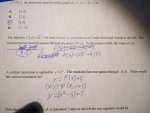GuavaEater
New member
- Joined
- Feb 9, 2017
- Messages
- 13
Hey there, I'm struggling with two functions questions. They are in the picture attached, as well as the work I've attempted doing on both questions.
The first question is "The function f(x) = √x + 5 is transformed by a translation of 2 units down and 4 units to the left. The transformation function passes through the point (20,y). To the nearest tenth, the value of y is _________."
What I attempted to do is solve by adding the movements into the function, which looked like this: f(x) = (√x - 4) + 3, which when using the number 20 for x. I then used my graphing calculator and plugged that in, went to the graphing table, and found where x = 20, and took the y co-ordinate from that point.
The second question is "A vertical translation is applied to y = x2. The translated function passes through (3,5). What would the vertical translation be?"
This one I did less on, as I'm not sure where to start. I just assumed that I could state (x,y) translates to (x,y+5), but that clearly isn't right. I also tried y= (x2 - 3) + 5, to insert the co-ordinates into the original function, but that seems wrong as well.
Any advice would be appreciated!
The first question is "The function f(x) = √x + 5 is transformed by a translation of 2 units down and 4 units to the left. The transformation function passes through the point (20,y). To the nearest tenth, the value of y is _________."
What I attempted to do is solve by adding the movements into the function, which looked like this: f(x) = (√x - 4) + 3, which when using the number 20 for x. I then used my graphing calculator and plugged that in, went to the graphing table, and found where x = 20, and took the y co-ordinate from that point.
The second question is "A vertical translation is applied to y = x2. The translated function passes through (3,5). What would the vertical translation be?"
This one I did less on, as I'm not sure where to start. I just assumed that I could state (x,y) translates to (x,y+5), but that clearly isn't right. I also tried y= (x2 - 3) + 5, to insert the co-ordinates into the original function, but that seems wrong as well.
Any advice would be appreciated!

